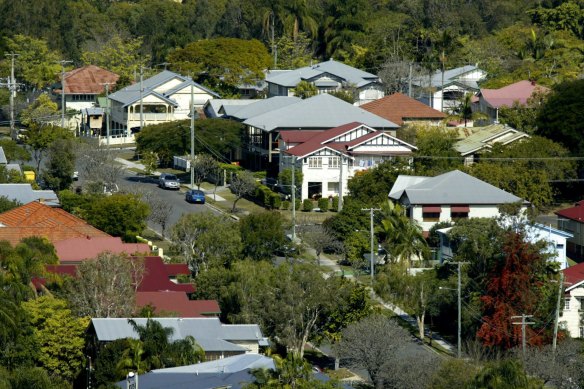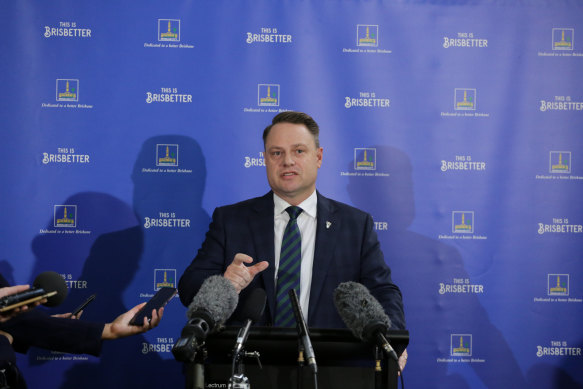- Analysis
- National
- Queensland
- City council
This was published 3 years ago
Brisbane rates, water charges up 26 per cent since 2004
By Matt Dennien
Brisbane residents are paying an average of 26 per cent more – after inflation – for their combined annual council rates and water utilities bills since the LNP took charge of Brisbane City Council’s budget in 2004, a Brisbane Times analysis shows.
The largest portion of the jump – 15 per cent – has come since the state government enterprise Queensland Urban Utilities took over water and sewerage charges from the council in 2010, driven largely by state bulk water fees.

Significant growth is set to take the number of properties paying Brisbane City Council rates to about 520,000 this financial year.Credit: Glenn Hunt
With the council’s fast-growing population approaching 1.3 million and what lord mayor Adrian Schrinner has described as “significant growth” to about 520,000 rateable properties this financial year, household revenue makes up a large portion of council’s $3.6 billion budget.
As a result of the growth and a 3.75 per cent average residential rise in rates for the year, council’s budget documents anticipate $1.25 billion in rates income in 2021-22.
The average owner-occupier’s rates bill will hit $1732.65 this year, compared with $1281.73 in 2010-11, or $1563.45 when adjusted for inflation.
The average residential Queensland Urban Utilities bill – the multi-council-owned body that has charged for water and sewerage since 2010 – has increased from $1157.78 (adjusted from $949.16) to $1395.60 over the same period.

Brisbane lord mayor Adrian Schrinner speaks to the media at City Hall before handing down council’s 2021-22 budget.Credit: Matt Dennien
The majority of this has come from increased state government bulk water charges, passed directly to the customer, which have risen from about one-third to nearly half of the total bill.
Combined, residential council rates and utility charges will reach an average of $3128.25 this year.
Queensland Urban Utilities, of which Brisbane is the largest shareholder, was formed amid an overhaul of the south-east Queensland water grid during the Millennium Drought and a long-running stoush between councils and the state government over rising water bills.
Prior to 2010, water and sewerage charges were handled directly by council and were included in rates bills. These, and the state’s bulk water fee, which was introduced after the government took over responsibility in 2008, are now paid to the utilities provider.
To reduce the price impact of significant investments in water infrastructure during the drought, the government initially set the fee below the cost of providing bulk water, with the debt to be repaid by increases phased in to 2028.
In the 2004-05 financial year, just months after Campbell Newman was elected as the Liberal lord mayor of a still-majority Labor council, he broke his pledge for a below-inflation rate rise and the average residential ratepayer’s bill, including water and sewerage charges, was $1663.92, or $2477.08 in today’s dollars.
Mr Newman would break a similar rates promise after the 2008 election before successfully keeping the increase down in 2011. His successor, Graham Quirk, moved away from such pledges the following year, when a 4.5 per cent rise was blamed on the federal Labor government’s carbon tax.
University of Queensland economics professor John Quiggin said generally speaking, if councils kept doing the same work, their costs would rise in line with economic growth rather than inflation.
“If you tried to raise rates revenue to CPI [consumer price index], you’d have no capacity to respond to population growth,” he said.
The link between inflation and rates is also played down by the local government sector more broadly.
Since 2005, the Local Government Association of Queensland has kept a “council cost index” based on Australian Bureau of Statistics wage, road and bridge construction prices, and inflation figures for the region.
This is weighted for the largest costs facing councils: wages, roads and transport, then general consumables, respectively. Due to its size, Brisbane also carries out some infrastructure projects usually overseen by states.
Property valuations also play a key part in council rates decisions.
In his budget reply speech last month, Labor Opposition Leader Jared Cassidy criticised the council’s recent rate rise – the highest in five years – for surpassing the rise in Brisbane’s CPI.
Finance committee chair Adam Allan hit back at the comments, saying the “modest” jump, after the average bill went backwards in 2020-21, was needed to support service and infrastructure demands, and was lower than rises after other crises and any link to CPI had been dismissed by economic experts.
“The increase in the CPI, a basket of household goods and services, does not reflect the cost of bridges, buses, CityCats or road upgrades,” he said. “We aren’t running a grocery shop, we are running Australia’s biggest council in Australia’s best and fastest-growing city.”
In a statement, Cr Allan said the average Brisbane household paid the lowest rates in south-east Queensland and was reaping the benefits of the biggest infrastructure, public transport and green space investments the city has seen.
Queensland Urban Utilities spokeswoman Michelle Cull said the company had invested more than $3 billion in capital works since it was formed, with an average annual price increase of 3.1 per cent.
A Regional Development, Manufacturing and Water Department spokesman said the south-east water grid’s resilience was becoming more important amid patchy rainfall and greater population demand, with bulk water price rises reducing the chance of higher jumps in the future.
The Morning Edition newsletter is your guide to the day’s most important and interesting stories, analysis and insights. Sign up here.
clarification
A previous version of this article said Queensland Urban Utilities took over bulk water charges in 2010. The company took over the city’s water and sewerage, which included directly passing on the state government’s state bulk water charge to residents alongside its own fees.